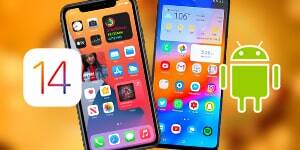
Android Comparison to iOS 14
It can be intimidating trying to understand mobile phone technology. To make things easier, we’ve created this article comparing and contrasting Android features and those of Apple’s new iOS 14.
Apple has introduced a massive update for iOS 14 unveiling many new features, some of which have long been present in Android devices.
Home Screen Widgets
After 13 years of keeping the iOS home screen static, Apple has finally allowed users to add Home Screen interactive widgets. Widgets appeared in Android’s OS with the release of their very first phone. Google continues to expand this feature, giving users the ability to customize their home screens even further.
App Library
The App Library is one of the first innovations of iOS 14. It resembles the Google Apps List. Unlike Android’s app list, Apple’s App Library automatically sorts apps and games into categories.
Default Browser and Mail Application
Android users have always had the freedom of setting various browsers and mail apps as their default. Apple could’ve implemented this feature more than 10 years ago but chose not to. iOS 14 will finally allow users to choose their default mail app and browser over Apple’s Mail app and Safari.
New Dialer
With the introduction of iOS 14 calls won’t take up your entire screen and can be minimized if necessary. In comparison, the new design of the “compact dialer” appeared in Android devices back in 2014.
App Slice vs App Clips
One of the most interesting features for application developers is Apple’s App Clips. This allows you to run “light” versions of programs to test them out. You can use these apps with limited functionality on iOS 14 without having to install them. This great idea was also introduced by Google previously. The App Slice feature, which debuted on Android’s OS back in 2018, had similar capabilities.
Bicycle Paths On Maps
With Bicycle paths on maps in iOS 14, Apple added new cycling features to the Maps App. These features include displaying bike paths and creating special routes based on stairs and ascents. This innovation is available in some major cities. Google Maps implemented this feature back in 2010 and it’s available worldwide.
Translator
Translator is another Google service. Its counterpart has been introduced into the Apple iOS 14. Like Google Translate, Apple’s new application allows you to translate typed and dictated phrases. It also offers integrated Safari support for translating entire web pages. Unfortunately, Apple’s Translate app is limited to 12 languages.
Picture-in-Picture
Apple has introduced the picture-in-picture functionality in iOS 11 for its iPad. However, iPhones will only get this video playback mode in iOS 14. This happened two months before the announcement of a similar option found in Android 8.0
Password Monitoring
Password monitoring is another feature first introduced by Google. In late 2019, Chrome received an update that alerts an end-user when their password is compromised by a data breach. Now Safari can do the same.
Setting a Password
While newer Android phones offer numerous biometric methods for unlocking, every phone still requires one of three traditional locking methods: pattern, PIN, or password.
Better Privacy
Now you can review permissions for installed apps. Remove apps you no longer use and consider replacing some with ones that require less personal information.
Battery Consumption
Switch your phone into power saver mode, which will automatically cut back on functions that consume battery life. You can also activate Adaptive power saving mode, which sits on top of your other power settings and helps you manage battery usage based on when you use the device and when it’s in your pocket.
As you can see, both Google and Apple have borrowed features from one another and will most likely continue to do so with future updates.
.png?width=170&height=76&name=POND_Mobile_Global_Roaming_black%20(2).png)
